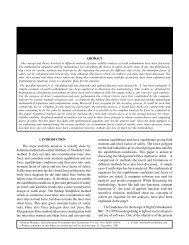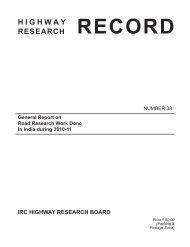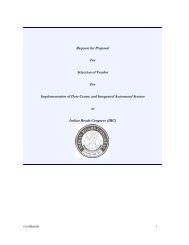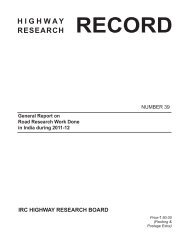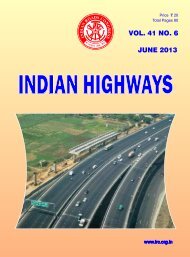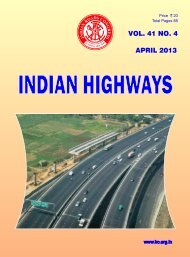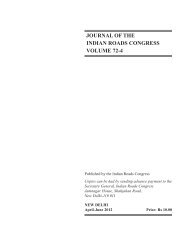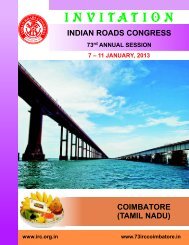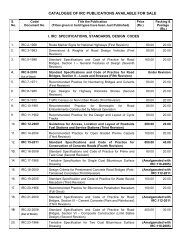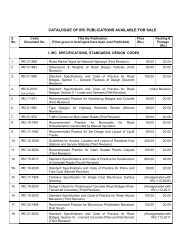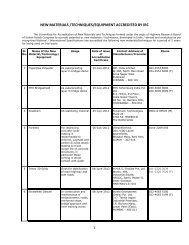A Review of Highway Agencies in the South Asia Region
A Review of Highway Agencies in the South Asia Region
A Review of Highway Agencies in the South Asia Region
Create successful ePaper yourself
Turn your PDF publications into a flip-book with our unique Google optimized e-Paper software.
A <strong>Review</strong> <strong>of</strong> <strong>Highway</strong> <strong>Agencies</strong> <strong>in</strong> <strong>the</strong> <strong>South</strong> <strong>Asia</strong> <strong>Region</strong><br />
agencies. In <strong>the</strong> end, <strong>the</strong> achieved values <strong>of</strong> <strong>the</strong> <strong>in</strong>dicators should be reported to managers<br />
with<strong>in</strong> <strong>the</strong> agency so as to monitor performance and take action accord<strong>in</strong>gly.<br />
5.3 Phase 2: Monitor<strong>in</strong>g and Improv<strong>in</strong>g Performance<br />
Phase 1 should have resulted <strong>in</strong> <strong>the</strong> reforms mentioned above, <strong>in</strong>clud<strong>in</strong>g <strong>the</strong> collection <strong>of</strong><br />
basic data and <strong>in</strong>formation. The subsequent phase should aim at improv<strong>in</strong>g performance<br />
<strong>in</strong> accordance with <strong>the</strong> annual performance agreement and <strong>the</strong> long-term strategy <strong>of</strong><br />
<strong>the</strong> agency. The <strong>in</strong>put and <strong>in</strong>termediate outcome <strong>in</strong>dicators, which are relatively easy to<br />
implement, should now be monitored, and <strong>the</strong> agency should take action to align <strong>the</strong><br />
realized values with agreed targets, monitor<strong>in</strong>g systems and procedures that have been put<br />
<strong>in</strong> place.<br />
Phase 2 should ideally start with <strong>the</strong> negotiation <strong>of</strong> an annual performance agreement<br />
between <strong>the</strong> highway agency and its parent m<strong>in</strong>istry. For successful and fruitful<br />
negotiations, both organizations will need to build a knowledge base to ensure both<br />
‘know what <strong>the</strong>y are talk<strong>in</strong>g about’. In this way, <strong>the</strong> negotiations can focus on reach<strong>in</strong>g<br />
an agreement that is both acceptable and feasible <strong>in</strong> terms <strong>of</strong> <strong>the</strong> targets <strong>of</strong> <strong>the</strong> highway<br />
agency as well as <strong>the</strong> obligations <strong>of</strong> <strong>the</strong> parent organization.<br />
5.3.1 Reforms Internal to <strong>the</strong> <strong>Highway</strong> Agency<br />
Availability <strong>of</strong> Appropriately Qualified Staff<br />
Reform <strong>in</strong> <strong>the</strong> highway sector requires highway agencies to change <strong>the</strong> way <strong>the</strong>y conduct<br />
<strong>the</strong>ir bus<strong>in</strong>ess. Such a shift demands that <strong>the</strong> agencies improve <strong>the</strong> skill mix with<strong>in</strong><br />
<strong>the</strong> organizations. The focus should shift from eng<strong>in</strong>eer<strong>in</strong>g skills to managerial and<br />
f<strong>in</strong>ancial skills that are needed to manage an agency centered on deliver<strong>in</strong>g a technically,<br />
socioeconomically and f<strong>in</strong>ancially sound network. The agency’s staff will need to design<br />
f<strong>in</strong>ancial structures, as well as understand <strong>the</strong> f<strong>in</strong>ancial and socioeconomic implications<br />
<strong>of</strong> technical decisions. They will also need to manage contractors and concessionaires to<br />
ensure <strong>the</strong> organization’s targets are achieved and contracts adhered to. In short, this<br />
implies that highway agencies should, besides recruit<strong>in</strong>g eng<strong>in</strong>eers only, expand <strong>the</strong> skill<br />
mix to <strong>in</strong>clude economists, planners, f<strong>in</strong>ance specialists, sociologists and environmentalists<br />
as well.<br />
Required Reforms<br />
It should be understood that now that <strong>the</strong> highway agency is bound to a long-term strategy<br />
and performance targets, it will need a different approach to plann<strong>in</strong>g. Plann<strong>in</strong>g can<br />
no longer be narrowly focused on <strong>the</strong> detailed design <strong>of</strong> a particular project but on <strong>the</strong><br />
identification, prioritization and sequenc<strong>in</strong>g <strong>of</strong> capital and ma<strong>in</strong>tenance projects.<br />
To acquire such skills, two basic reforms need to be implemented by <strong>the</strong> highway agencies<br />
<strong>in</strong> <strong>South</strong> <strong>Asia</strong>. Firstly, a revision <strong>of</strong> recruitment rules, so that <strong>the</strong> agencies are able to<br />
hire new staff <strong>in</strong>dependently through <strong>the</strong> market-based competitive process <strong>in</strong>stead<br />
<strong>of</strong> depend<strong>in</strong>g on centralized hir<strong>in</strong>g, bound by <strong>the</strong> government’s str<strong>in</strong>gent recruitment<br />
program. This will demand that <strong>the</strong> agency develop well-def<strong>in</strong>ed rules for staff recruitment.<br />
These rules need to be flexible to <strong>the</strong> extent that <strong>the</strong> agency is able to respond on time to<br />
<strong>the</strong> requirements <strong>of</strong> ma<strong>in</strong>ta<strong>in</strong><strong>in</strong>g or improv<strong>in</strong>g its performance. Flexibility also implies that<br />
<strong>the</strong> agency should be able to term<strong>in</strong>ate employment <strong>of</strong> staff <strong>in</strong> case <strong>of</strong> lack <strong>of</strong> performance.<br />
Secondly, <strong>the</strong> highway agency will need to <strong>of</strong>fer its staff a roadmap for career development.<br />
To encourage staff members to contribute to <strong>the</strong> achievement <strong>of</strong> <strong>the</strong> agency’s targets,<br />
staff members will need to be motivated. A well def<strong>in</strong>ed career growth path is one way<br />
to motivate staff; a prime example is merit-based promotions. Ano<strong>the</strong>r is protection<br />
72



